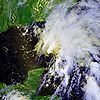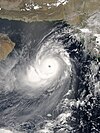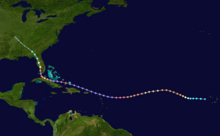Portal:Tropical cyclones
The Tropical Cyclones Portal

A tropical cyclone is a storm system characterized by a large low-pressure center, a closed low-level circulation and a spiral arrangement of numerous thunderstorms that produce strong winds and heavy rainfall. Tropical cyclones feed on the heat released when moist air rises, resulting in condensation of water vapor contained in the moist air. They are fueled by a different heat mechanism than other cyclonic windstorms such as Nor'easters, European windstorms and polar lows, leading to their classification as "warm core" storm systems. Most tropical cyclones originate in the doldrums, approximately ten degrees from the Equator.
The term "tropical" refers to both the geographic origin of these systems, which form almost exclusively in tropical regions of the globe, as well as to their formation in maritime tropical air masses. The term "cyclone" refers to such storms' cyclonic nature, with anticlockwise rotation in the Northern Hemisphere and clockwise rotation in the Southern Hemisphere. Depending on its location and intensity, a tropical cyclone may be referred to by names such as "hurricane", "typhoon", "tropical storm", "cyclonic storm", "tropical depression" or simply "cyclone".
Types of cyclone: 1. A "Typhoon" is a tropical cyclone located in the North-west Pacific Ocean which has the most cyclonic activity and storms occur year-round. 2. A "Hurricane" is also a tropical cyclone located at the North Atlantic Ocean or North-east Pacific Ocean which have an average storm activity and storms typically form between May 15 and November 30. 3. A "Cyclone" is a tropical cyclone that occurs in the South Pacific and Indian Oceans.
Selected named cyclone -
Hurricane Pali was the earliest-forming Pacific hurricane on record, being the first Pacific hurricane to occur in January since Hurricane Ekeka of 1992. The first tropical cyclone of the 2016 Pacific hurricane season, Pali originated as an area of low pressure within a persistent trough, near the equator on January 6, 2016. Deep convection gradually built up around the center of the disturbance as the system curved northward, before it organized into a tropical depression on the next day, making the system the earliest recorded tropical cyclone in the Pacific hurricane basin. The system quickly intensified into a tropical storm, resulting in it being named Pali. During the next few days, Pali slowly moved northward while slowly curving towards the west, strengthening somewhat before weakening due to the presence of wind shear. On January 10, Pali slowly turned eastward and proceeded to re-strengthen as wind shear diminished.
On January 12, Pali strengthened into a Category 1 hurricane on the Saffir–Simpson scale (SSWHS) while curving towards the south. The next day, Pali reached its peak intensity as a Category 2 hurricane, with 1-minute maximum sustained winds of 100 mph (155 km/h) and a minimum central pressure of 978 mbar (hPa; 28.88 inHg). Afterward, Pali quickly began to weaken, as the storm encountered stronger wind shear, with the storm weakening into a Category 1 hurricane several hours later, before weakening into a tropical storm later that day. On January 14, Pali weakened into a tropical depression before degenerating into a remnant low the next day, since conditions became increasingly hostile. Later that day, Pali's remnants dissipated near the same location where they had formed roughly a week ago. Pali formed and tracked near the equator, forming at a latitude of 3.3°N and tracking as low as 2.6°N as a tropical depression. This made Pali the second-lowest latitude tropical cyclone on record in the Western Hemisphere at the time, which was extremely unusual, given the unfavorable conditions that are usually in place around the equator. (Full article...)Selected article -
Hurricane Irma was an extremely powerful Cape Verde hurricane that caused extensive damage in the Caribbean and Florida. Lasting from late August to mid-September 2017, the storm was the strongest open-Atlantic tropical cyclone on record and the first Category 5 hurricane to strike the Leeward Islands. Classified as the ninth named storm, fourth hurricane, and second major hurricane of the hyperactive 2017 Atlantic hurricane season, Irma developed from a tropical wave near the Cape Verde Islands on August 30. Favorable conditions allowed the cyclone to become a hurricane on the following day and then rapidly intensify into a major hurricane by September 1 as it moved generally westward across the Atlantic. However, dry air and eyewall replacement cycles disrupted further strengthening, with fluctuations in intensity during the next few days. Irma resumed deepening upon encountering warmer sea surface temperatures, while approaching the Lesser Antilles on September 4. The system reached Category 5 intensity on the following day and peaked with winds of 180 mph (290 km/h) shortly thereafter.
Irma made its first landfall on Barbuda early on September 6 at peak intensity. The hurricane also struck Saint Martin and Virgin Gorda in the British Virgin Islands at Category 5 intensity later that day. Upon clearing the Leeward Islands, the cyclone continued west-northwestward toward the Bahamas. Around the time of landfall on Little Inagua Island early on September 8, Irma weakened to a Category 4 hurricane, after being a Category 5 hurricane for about 60 consecutive hours, the second longest contiguous time period as a Category 5 hurricane on record. Late on September 8, the storm re-intensified to Category 5 southwest of Ragged Island. Irma made landfall near Cayo Romano, Cuba, at that intensity, becoming the first Category 5 hurricane to strike the island since 1924. Although land interaction weakened Irma to a high-end Category 2 hurricane, the system re-intensified to Category 4 status as it crossed the warm waters of the Straits of Florida, before making landfall on Cudjoe Key on September 10. Irma weakened to Category 3 status prior to another landfall in Florida on Marco Island later that day. The system degraded into a remnant low over Alabama, and ultimately dissipated on September 13 over Missouri. (Full article...)Selected image -

Selected season -

The 1998 Atlantic hurricane season was a catastrophic and deadly Atlantic hurricane season, featuring the highest number of storm-related fatalities in over 218 years and some of the costliest ever at the time. The season had above average activity, due to the dissipation of an El Niño event and transition to La Niña conditions. It officially began on June 1 and ended on November 30, dates which conventionally delimit the period during which most tropical cyclones form in the Atlantic Ocean. The season had a rather slow start, with no tropical cyclones forming in June. The first tropical cyclone, Tropical Storm Alex, developed on July 27, and the season's final storm, Hurricane Nicole, became extratropical on December 1.
Several storms made landfall or directly affected land. Hurricane Bonnie made landfall in southeastern North Carolina as a Category 2 hurricane in late August, killing five people and causing about $1 billion in damage. Hurricane Earl caused $79 million in damage and three deaths after making landfall in Florida as a Category 1 hurricane. (Full article...)Related portals
Currently active tropical cyclones

Italicized basins are unofficial.
- North Atlantic (2024)
- No active systems
- East and Central Pacific (2024)
- No active systems
- West Pacific (2024)
- No active systems
- North Indian Ocean (2024)
- No active systems
- Mediterranean (2023–24)
- No active systems
- South-West Indian Ocean (2023–24)
- No active systems
- Australian region (2023–24)
- No active systems
- South Pacific (2023–24)
- No active systems
- South Atlantic (2023–24)
- No active systems
Last updated: 21:50, 2 June 2024 (UTC)
Tropical cyclone anniversaries

June 2,
- 2003 - Severe Tropical Storm Nangka reached its peak intensity to the south of Taiwan.
- 2007 - As a rapidly weakening storm, Tropical Depression Barry (pictured) makes landfall over in Florida before transitioning into an extratropical cyclone. Barry only killed three people in its path with damages of only $118 thousand.
June 3,
- 1982 - Tropical Storm 02B made landfall in India near Paradip, killing 140 people and destroying half a million homes.
- 2010 - Cyclone Phet struck eastern Oman, dropping heavy rainfall across normally arid areas; the storm killed 47 people and left US$861 million in damage.
- 2014 - Tropical Storm Boris makes landfall over in Southwestern Mexico as a weak system, killing a total of six people and US$46.8 million worth of damages.

June 4
- 2006 - Cyclone Gonu (pictured) became the strongest tropical cyclone on record in the Arabian Sea, with 3-minute winds of 155 km/h (100 mph); two days later, Gonu struck the Arabian Peninsula, killing 49 people and causing about $4 billion of damage.
- 2012 - Typhoon Mawar reaches peak intensity as a Category 3 typhoon.
- 2014 - Tropical Storm Boris makes landfall over Southwestern Mexico and kills 6 people with US$46.8 million in damages.
Did you know…




- …that the Joint Typhoon Warning Center considers that Typhoon Vera (pictured) of 1986 is actually two distinct systems, formed from two separated low-level circulations?
- …that Hurricane Agatha (pictured) was the strongest Pacific hurricane to make landfall in Mexico in May since records began in 1949?
- …that Cyclone Raquel (track pictured) travelled between the Australian and South Pacific basins between the 2014–15 and 2015–16 seasons, spanning both seasons in both basins?
- …that Cyclone Amphan (pictured) in 2020 was the first storm to be classified as a Super Cyclonic Storm in the Bay of Bengal since 1999?
General images -

Arizona has been affected by hurricanes on numerous occasions. Usually, these storms originate in the eastern Pacific Ocean, make landfall in the Mexican states of Baja California or Sonora, and dissipate before crossing into the United States. Thus, in most cases, it is only the tropical cyclones' remnant moisture that produces heavy rainfall—and in some occasions, flooding—in portions of Arizona. However, approximately every five years, a tropical cyclone retains sufficient strength to enter the state as a tropical storm or a tropical depression. Arizonans can expect indirect flash floods caused by the remnants of tropical cyclones to occur about every two years.
Tropical cyclones in Arizona are not common, since the predominant wind pattern steers most storms that form in the Eastern Pacific either parallel or away from the Pacific coast of northwestern Mexico. As a result, most storms that could affect Arizona are carried away from the United States, with only 6% of all Pacific hurricanes entering US territory. Not all Arizona hurricanes originate from the Pacific Ocean, however; in July 2008 an Atlantic hurricane named Hurricane Dolly produced rainfall in the eastern portion of the state, and another Atlantic storm reached Arizona as a tropical depression. Many, but not all, of these systems also impacted California. (Full article...)Topics
Subcategories
Related WikiProjects
WikiProject Tropical cyclones is the central point of coordination for Wikipedia's coverage of tropical cyclones. Feel free to help!
WikiProject Weather is the main center point of coordination for Wikipedia's coverage of meteorology in general, and the parent project of WikiProject Tropical cyclones. Three other branches of WikiProject Weather in particular share significant overlaps with WikiProject Tropical cyclones:
- The Non-tropical storms task force coordinates most of Wikipedia's coverage on extratropical cyclones, which tropical cyclones often transition into near the end of their lifespan.
- The Floods task force takes on the scope of flooding events all over the world, with rainfall from tropical cyclones a significant factor in many of them.
- WikiProject Severe weather documents the effects of extreme weather such as tornadoes, which landfalling tropical cyclones can produce.
Things you can do
 |
Here are some tasks awaiting attention:
|
Wikimedia
The following Wikimedia Foundation sister projects provide more on this subject:
-
Commons
Free media repository -
Wikibooks
Free textbooks and manuals -
Wikidata
Free knowledge base -
Wikinews
Free-content news -
Wikiquote
Collection of quotations -
Wikisource
Free-content library -
Wikiversity
Free learning tools -
Wikivoyage
Free travel guide -
Wiktionary
Dictionary and thesaurus
























































